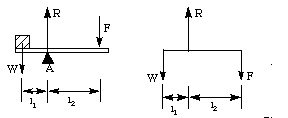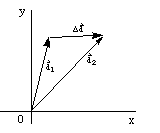|
This chapter introduces the basic physical principles behind mechanisms as
well as basic concepts and principles required for this course.
Force: an agent or influence that, if applied to a free body results
chiefly in an acceleration of the body and sometimes in elastic deformation and
other effects.
Every day we deal with forces of one kind or another. A
pressure is a force. The earth exerts a force of attraction for all bodies or
objects on its surface. To study the forces acting on objects, we must know how
the forces are applied, the direction of the forces and their value.
Graphically, forces are often represented by a vector whose end represents the
point of action.
A mechanism is what is responsible for any action or reaction.
Machines are based on the idea of transmitting forces through a series of
predetermined motions. These related concepts are the basis of dynamic movement.
Torque: Something that produces or tends to produce rotation and
whose effectiveness is measured by the product of the force and the
perpendicular distance from the line of action of the force to the axis of
rotation.
Consider the lever shown in
Figure 1-1. The lever is a bar that is free to turn about the fixed point,
A, called the fulcrum; a weight acts on the one side of the lever, and a
balancing force acts on the other side of the lever.

To analyze levers, we need to find the torques
of the forces acting on the lever. To get the torque of force W about
point A, multiply W by l1, its distance from A. Similarly F x
l2 is the torque of F about fulcrum A.
Motion: a change of position or orientation.
We begin our study of motion with the simplest case, motion in a straight
line.
- Position and displacement along a line
The first step in the study of motion is to describe the position of a
moving object. Consider a car on an east-west stretch of straight highway.
We can describe the displacement of the car by saying "the car
is 5 kilometers west of the center town". In this description, we specified
two factors, the original point of measure and the direction of the
displacement.
- Velocity
We can define the velocity of an object moving steadily as its
displacement per unit time:

(1-1)
where t = t2 - t1 is the time interval during which the displacement
occurred. When velocity varies, we can let the time interval become
infinitesimally small, thus

(1-2)
- Acceleration
Acceleration is the variation of the velocity in a unit time period.
If the velocity changes in a constant rate, then we can describe the
acceleration by

(1-3)
More generally, acceleration is

(1-4)
The picture becomes more complicated when the motion is not merely along a
straight line, but rather extends into a plane. Here we can describe the motion
with a vector which includes the magnitude and the direction of movement.
- Position vector and displacement vector
The directed segment which describes the position of an object relative to
an origin is the position vector, as d1 and d2
in Figure 1-2

Figure 1-2 Position vector and displacement vector
If we wish to describe a motion from position d1 to
position d2, for example, we can use vector d1,
the vector starts at the point described by d1 and goes to
the point described by d2, which is called the
displacement vector.

(1-5)
- Velocity vector
For a displacement
 d
occurring in a time interval d
occurring in a time interval
 t,
the average velocity during the interval is t,
the average velocity during the interval is

(1-6)
Clearly Vave has the direction of
 d. d.
In the limit as delta t approaches zero, the instantaneous velocity is

(1-7)
The direction of V is the direction of
 d
for a very small displacement; it is therefore along, or tangent to, the
path. d
for a very small displacement; it is therefore along, or tangent to, the
path.
- Acceleration vector
The instantaneous acceleration is the limit of the ratio
 V/ V/ t
as t
as
 t
becomes very small: t
becomes very small:
 (1-8)
(1-8)
The previous sections discuss the motion of particles. For a rigid body in a
plane, its motion is often more complex than a particle because it is comprised
of a linear motion and a rotary motion. Generally, this kind of motion can be
decomposed into two motions (Figure
1-3), they are:
- The linear motion of the center of the mass of the rigid body. In this
part of the motion, the motion is the same as the motion of a particle on a
plane.
- The rotary motion of the rigid body relative to its center of mass.

Figure 1-3 Motion of a rigid body in a plane
When no force is exerted on a body, it stays at rest or moves in a straight
line with constant speed. This principle of inertia is also known as
Newton's first law. It is from this law that Newton was able to build up
our present understanding of dynamics.
From our daily life, we can can observe that:
- When a force F is applied on an object,
 V,
the change of the velocity of the object, increases with the length of time
delta t increases; V,
the change of the velocity of the object, increases with the length of time
delta t increases;
- The greater the force F, the greater
 V;
and V;
and
- The larger the body (object) is, the less easily accelerated by forces.
It is convenient to write the proportionality between F t
and t
and
 V
in the form: V
in the form:
 (1-9)
(1-9)
The proportionality constant m varies with the object. This constant
m is refered to as the inertial mass of the body. The
relationship above embodies Newton's law of motion (Newton's
second law). As
 (1-10)
(1-10)
in which a is the acceleration of the object. We have
 (1-11)
(1-11)
If m = 1 kg and a = 1m/sec2, than F = 1 newton.
Forces and accelerations are vectors, and Newton's law can be written in
vector form.
 (1-12)
(1-12)
Try to make a baseball and a cannon ball roll at the same speed. As you can
guess, it is harder to get the cannon ball going. If you apply a constant force
F for a time
 t,
the change in velocity is given by
Equation 1-9. So, to get the same t,
the change in velocity is given by
Equation 1-9. So, to get the same
 v,
the product F v,
the product F t
must be greater the greater the mass m you are trying to accelerate. t
must be greater the greater the mass m you are trying to accelerate.
To throw a cannon ball from rest and give it the same final velocity as a
baseball (also starting from rest), we must push either harder or longer. What
counts is the product F t.
This product F t.
This product F t
is the natural measure of how hard and how long we push to change a motion. It
is called the impulse of the force. t
is the natural measure of how hard and how long we push to change a motion. It
is called the impulse of the force.
Suppose we apply the same impulse to a baseball and a cannon ball,
both initially at rest. Since the initial value of the quantity mv
is zero in each case, and since equal impulses are applied, the final values mv
will be equal for the baseball and the cannon ball. Yet, because the mass of the
cannon ball is much greater than the mass of the baseball, the velocity of the
cannon ball will be much less than the velocity of the baseball. The product
mv, then, is quite a different measure of the motion than simply v
alone. We call it the momentum p of the body, and measure
it in kilogram-meters per second.
 (1-13)
(1-13)
Velocity and momentum are quite different concepts: velocity
is a kinematical quantity, whereas momentum is a dynamic one,
connected with the causes of changes in the motion of masses.
Because of its connection with the
impulse which occurs naturally in Newton's law (Equation 1-9), we
expect momentum to fit naturally into Newtonian dynamics. Newton did
express his law of motion in terms of the momentum, which he called the
quantity of motion. We can express Newton's law in terms of the change in
momentum instead of change in velocity:
 (1-14)
(1-14)
where v and v' are the velocities before and after the impulse.
The right-hand side of the last equation can be written as
 (1-15)
(1-15)
the change in the momentum. Therefore
 (1-16)
(1-16)
or, in other words, the impulse equals the change in the momentum.
In
Figure 1-4 a moving billiard ball collides with a billiard ball at rest. The
incident ball stops and the ball it hits goes off with the same velocity with
which the incident ball came in. The two billiard balls have the same mass.
Therefore, the
momentum of the second ball after the collision is the same as that
of the incident ball before collision. The incident ball has lost all its
momentum, and the ball it struck has gained exactly the momentum
which the incident ball lost.

Figure 1-4 Collision of billiard balls
This phenomenon is consistent with the law of conservation of momentum
which says that the total momentum is constant when two bodies interact.
Work is a force applied over a distance. If you drag an object
along the floor you do work in overcoming the friction between the object
and the floor. In lifting an object you do work against gravity which
tends to pull the object toward the earth. Steam in a locomotive cylinder does
work when it expands and moves the piston against the resisting forces.
Work is the product of the resistance overcome and the distance
through which it is overcome.
Power is the rate at which
work is done.
In the British system, power is expressed in foot-pounds per second. For
larger measurements, the horsepower is used.
1horsepower = 550ft *lb/s = 33,000ft*lb/min
In SI units, power is measured in joules per second, also called
the watt (W).
1hp = 746 W = 0.746kW
All object possess energy. This can come from having work done on it at
some point in time. Generally, there are two kinds of energy in mechanical
systems, potential and kinetic. Potential energy is due to the
position of the object and kinetic energy is due to its movement.
For example, an object set in motion can overcome a certain amount of
resistance before being brought to rest, and the energy which the object has on
account of its motion is used up in overcoming the resistance, bring the object
to rest. Fly wheels on engines both receive and give up energy and
thus cause the energy to return more smoothly throughout the stroke.
Elevated weights have power to do
work on account of their elevated position, as in various types of
hammers, etc.
|

